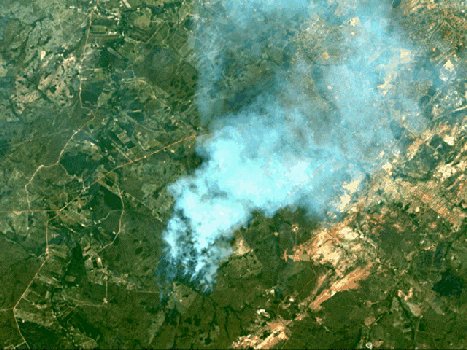| Deforestation |
| Europe lost most of its forest cover to agriculture through the middle ages. Centuries later, the forests of eastern North America followed as the land was settled by Europeans. Today, tropical rainforests are being lost at an even more rapid rate as trees are felled for hardwood, to provide land for commercial or subsistence farming, or to make way for access roads, mining operations and dams. This loss is more disastrous than it was in temperate regions due to the ecological complexity of the tropical forests.
This airborne image shows smoke from forest clearance near Cuiaba, Mato Groso, Brazil.
Sediment plumes off the coast of Borneo show where deforestation has led to soil erosion. A tropical rainforest acts as a huge moisture store and modifies the local climate. Once stripped of tree cover, thin forest soils are easily eroded and stream flow becomes more erratic. Increased flooding can produce siltation problems downstream. Forest soils are often quite poor, leading to farmers moving on to clear adjacent forest areas after only a few years.
Madagascar has lost 90% of its original forest cover, leaving only a thin line of forest along the eastern highlands.
Landsat images of part of Rondonia, Brazil, show forest areas cleared between 1975 (left) and 1992 (right). The area is about 45km (28m) across. Slash-and-burn forest clearance on the island of Borneo has produced huge problems in recent years as the monsoon rains which are relied on to quench the fires have been late arriving. The blazing forest even triggered fires in underlying peat deposits, so that the very earth was alight. Smoke spread hundreds of kilometres (miles) to Malaysia and Sumatra and hung over the area for several months in 1997. An airliner crashed due to poor visibility, killing 234, and several ships collided in the Strait of Mallacca. 20 million people sought treatment for respiratory and other illnesses.
This weather satellite image shows the smoke pall which enveloped southeast Borneo in 1997 (smoke appears yellow in contrast to the white clouds). Globally, tropical rainforests are significant absorbers of the greenhouse gas carbon dioxide, which is released when they are burned. Another greenhouse gas, methane, is produced in many cleared areas - as a by-product of cattle ranching in South America and wet rice cultivation in Asia. The tropical rainforests also represent the planet's richest ecosystem, with an unique diversity of animal and plant life. Even if trees are cleared from only a small area, or only selected trees are removed, other species in adjacent areas can be badly affected. Estimates are that habitat destruction causes the loss of 50-100 species a day, from the 5-30 million species thought to exist. |




